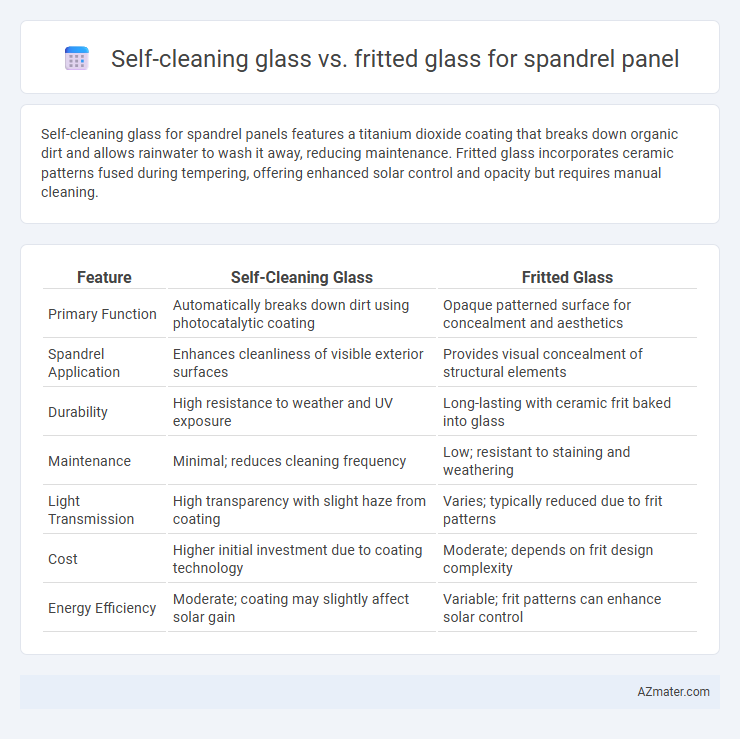Self-cleaning glass for spandrel panels features a titanium dioxide coating that breaks down organic dirt and allows rainwater to wash it away, reducing maintenance. Fritted glass incorporates ceramic patterns fused during tempering, offering enhanced solar control and opacity but requires manual cleaning.
Table of Comparison
| Feature | Self-Cleaning Glass | Fritted Glass |
|---|---|---|
| Primary Function | Automatically breaks down dirt using photocatalytic coating | Opaque patterned surface for concealment and aesthetics |
| Spandrel Application | Enhances cleanliness of visible exterior surfaces | Provides visual concealment of structural elements |
| Durability | High resistance to weather and UV exposure | Long-lasting with ceramic frit baked into glass |
| Maintenance | Minimal; reduces cleaning frequency | Low; resistant to staining and weathering |
| Light Transmission | High transparency with slight haze from coating | Varies; typically reduced due to frit patterns |
| Cost | Higher initial investment due to coating technology | Moderate; depends on frit design complexity |
| Energy Efficiency | Moderate; coating may slightly affect solar gain | Variable; frit patterns can enhance solar control |
Introduction to Spandrel Panels in Modern Architecture
Spandrel panels conceal structural elements and mechanical systems in modern architecture, enhancing a building's aesthetic while providing insulation and weather resistance. Self-cleaning glass uses photocatalytic coatings to reduce maintenance by breaking down organic dirt, making it ideal for high-rise spandrel applications. Fritted glass incorporates ceramic patterns fused onto the glass surface, offering solar control and privacy benefits without compromising structural integrity.
What is Self-Cleaning Glass?
Self-cleaning glass features a special coating that uses sunlight to break down organic dirt and rainwater to wash away debris, reducing maintenance for spandrel panels. The hydrophilic coating prevents water spots and enhances transparency, making it ideal for building exteriors where access for cleaning is limited. Unlike fritted glass, which relies on ceramic patterns for shading and aesthetics, self-cleaning glass actively reduces grime build-up, improving overall glass performance and lifespan.
Understanding Fritted Glass Technology
Fritted glass technology involves applying ceramic frits to glass surface, providing enhanced durability and design flexibility for spandrel panels by controlling light transmission and reducing solar heat gain. Compared to self-cleaning glass, fritted glass offers superior opacity and aesthetic customization, crucial for concealing building infrastructure without compromising energy efficiency. This technology enables architects to balance visual appeal with functional performance, ensuring effective facade integration in modern construction.
Performance Comparison: Self-Cleaning vs Fritted Glass
Self-cleaning glass for spandrel panels utilizes photocatalytic and hydrophilic coatings to break down organic dirt and promote water sheeting, resulting in reduced maintenance and longer-lasting clarity compared to fritted glass. Fritted glass features ceramic patterns that provide shading, diffused light, and enhanced privacy but does not actively reduce dirt accumulation or cleaning frequency. Performance-wise, self-cleaning glass offers superior maintenance efficiency and optical clarity, while fritted glass excels in energy control and aesthetic customization without inherent self-cleaning properties.
Aesthetic Differences in Spandrel Panel Applications
Self-cleaning glass in spandrel panels offers a sleek, uninterrupted surface that enhances modern minimalist aesthetics through its clear, reflective finish. Fritted glass introduces patterned designs or textures, providing visual interest and depth while allowing for customization in architectural expression. The choice between these materials impacts the building facade's appearance by balancing cleanliness and maintenance with decorative appeal and light diffusion effects.
Energy Efficiency and Thermal Performance
Self-cleaning glass in spandrel panels enhances energy efficiency by reducing the need for manual cleaning, which helps maintain optimal solar heat gain and natural light transmission, lowering HVAC energy consumption. Fritted glass improves thermal performance through its patterned ceramic frit that controls solar heat gain, reduces glare, and increases shading, thereby minimizing cooling loads. Both technologies contribute to energy savings, but fritted glass offers superior solar control, while self-cleaning glass supports long-term efficiency through maintenance reduction.
Maintenance and Longevity Considerations
Self-cleaning glass for spandrel panels significantly reduces maintenance efforts by utilizing photocatalytic and hydrophilic coatings that break down organic dirt and allow rainwater to wash away residues. Fritted glass, with its ceramic frit pattern, offers enhanced durability against scratches and UV degradation, extending panel longevity but requires periodic manual cleaning to prevent grime buildup in the fritted areas. Choosing between self-cleaning and fritted glass hinges on balancing the lower maintenance advantages of self-cleaning coatings against the proven, robust lifespan and structural benefits of fritted glass in high-exposure environments.
Environmental Impact and Sustainability
Self-cleaning glass for spandrel panels reduces the need for harsh chemical cleaners and frequent maintenance, decreasing water consumption and chemical runoff in urban environments. Fritted glass enhances building energy efficiency by controlling solar heat gain, thereby reducing cooling loads and carbon emissions. Both technologies contribute to sustainable building practices, with self-cleaning glass prioritizing maintenance environmental impact and fritted glass optimizing operational energy performance.
Cost Analysis: Initial and Long-Term Investment
Self-cleaning glass typically incurs higher initial costs due to advanced coatings that reduce maintenance frequency, resulting in lower long-term cleaning expenses and extended panel lifespan. Fritted glass offers a more affordable upfront price with durable ceramic patterns but may require more frequent cleaning or replacement depending on environmental conditions. Evaluating total cost of ownership reveals self-cleaning glass often justifies its premium through decreased labor and cleaning material expenses over time in spandrel panel applications.
Choosing the Right Glass for Your Spandrel Panel Project
Selecting the right glass for spandrel panels hinges on balancing aesthetics, durability, and maintenance requirements. Self-cleaning glass features hydrophilic coatings that break down organic dirt and enable rainwater to wash away debris, reducing cleaning efforts and ensuring long-term clarity. Fritted glass incorporates ceramic patterns baked onto the surface, offering enhanced solar control and privacy while allowing design flexibility, making it ideal for projects prioritizing energy efficiency and architectural appeal.

Infographic: Self-cleaning glass vs Fritted glass for Spandrel panel
 azmater.com
azmater.com